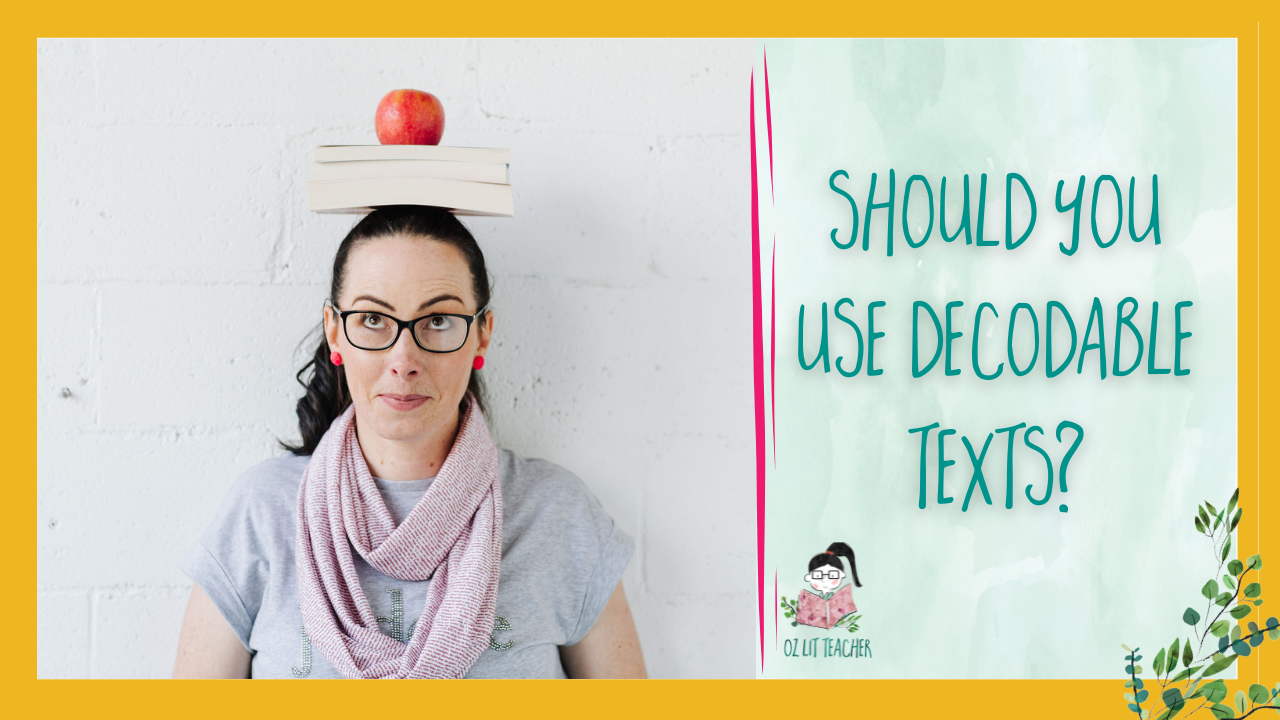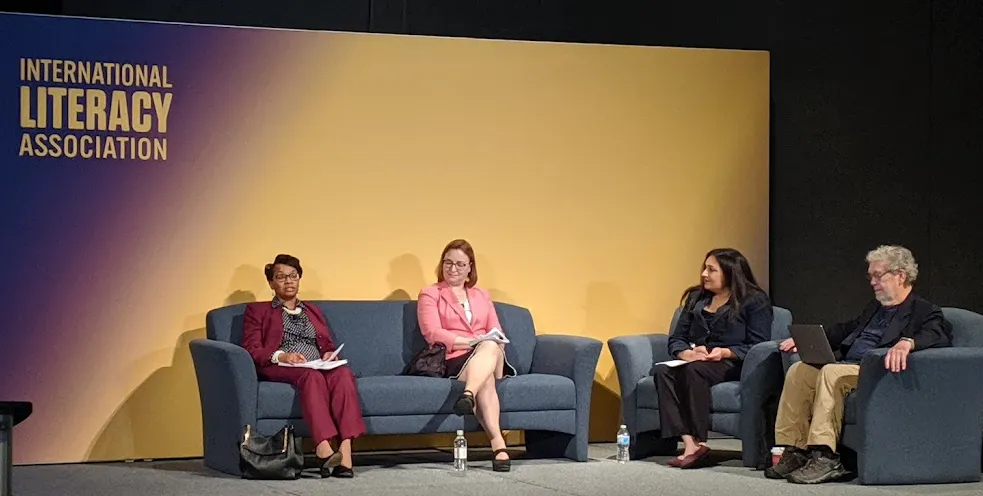
Should You Use Decodable Texts?
May 29, 2022I've been asked loads of questions about effective phonics instruction lately so today I'm going to address one of the main questions being asked at the moment: Should we use decodable texts? This question is usually followed by a whole lot more:
- Are all decodable texts useful?
- Will they automatically improve reading?
- Which 'side' are you on?
- Are 'sides' even helpful?
In this blog I'm laying out my current thoughts on using decodable texts in the reading classroom. You might be surprised by what I have to say...
The journey to my current view
It makes sense that if you fly across the other side of the world just to hear your favourite researcher speak, you have to listen to what she says - even if some of it makes you feel a bit uncomfortable.
That was the case for me back in 2019, when I finally got to hear from my research idol, Nell K. Duke, as part of an International Literacy Association discussion panel titled, ‘What Research Really Says about Teaching Reading- And Why That Still Matters’.
Three specific comments from that panel discussion challenged my thinking and have formed the basis for my evolving approach to literacy instruction ever since.
The first 2 comments were delivered by P. David Pearson (another one of my research idols). In his opening address, Pearson outlined 6 ‘rules of the road’ for dealing with research related to reading instruction. He suggested that, as uncomfortable as it may be, in order to get the best outcomes for all students, educators needed to ‘play by the rules’ when it came to referring to and using research.
I distinctly remember two of his rules hitting home for me that day:
- Rule #2: “When research is applied, it ought to be applied in an even-handed way. No cherry picking. You must look at all research, not just the bits that fit your biases” (ILA, 2019).
- Rule #6: “You must stay at the table and cut through the rhetoric. While individuals tend to stay with people who are like them, this approach is bad for educational policy and a problem for society today” (ILA, 2019).
Upon hearing these rules, I challenged myself to listen to the remainder of the panel discussions with a completely open mind and heart. New mantra: “Get outside your own echo chamber. Don’t cherry pick research.”
And that’s when Nell Duke came along and severely tested my resolve with this newly adopted mantra…
When asked about what the research says about decodable texts Duke dropped a bombshell: “Even though it’s not what some people want to hear…when it comes to decodable texts, the weight of the evidence suggests decodability is an important factor in texts for beginning readers. The degree to which the texts are decodable does matter for children and for their development. More decodable texts foster literacy development better.”
The gasp in the room was audible.
The mantra in my mind was loud:
“Get outside your own echo chamber. Don’t cherry pick research. Get outside your own echo chamber. Don’t cherry pick research. Get outside your own echo chamber. Don’t cherry pick research.”
As hard as it was, I forced myself to push down all the objections, questions and concerns that were rising from within (potentially the same ones that may be rising within you as you read this), and listened to the remainder of Duke’s comments on the topic.
Duke discussed the idea that decodability wasn’t the only important factor in text selection for beginning readers, citing ‘diversity of genres, natural language and the degree to which the text engaged kids’ as equally important factors.
That panel discussion certainly challenged me, but I left with Pearson’s wise words in my mind: if educators are serious about delivering high-quality literacy instruction to every student, we have to get out of our own comfort zones, listen to other voices and consider all the research.
As a literacy consultant myself, I had an obligation to do the hard work of ‘staying at the table and cutting through the rhetoric’ to develop my own informed view.
I’ve done a lot of reading, engaged in a lot of robust discussion and worked in many classrooms since that panel discussion in 2019. All of which has lead me to my current views on the use of decodable texts in emergent reading instruction. (Note: I say ‘current views’ because I know that the best educators are lifelong learners whose thinking and practice continually evolve over time).
In today’s blog I’m going to share 3 shifts in my thinking across time (with more to come in next week's blog).

Learning 1: Not all decodables are created equal
One of my biggest worries about the use of decodable texts was the eradication of meaning for young readers.
I was worried that if students read these contrived texts, they’d come to believe that reading was purely about decoding and wouldn’t understand that the whole purpose of reading is to extract meaning. Worse still, they’d be turned off reading all together.
Unfortunately, this worry was confirmed for me time and time again, when I picked up decodable texts in schools only to find syntactically awkward sentences that were hard to follow and didn’t tell a connected, logical or engaging story. (What does ‘Pip on the tip’ even mean!?)
What I realise now is that not all decodables are created equal. Just as Nell Duke had said in her speech: decodability is important, but the quality of these books matters. And the evidence I have seen in classrooms certainly demonstrates that this quality is highly variable.
I now understand though that while there are some really poorly constructed decodable books, there are also some decent ones too – ones that live up to Nell Duke’s criteria of decodability, repetitiousness and engagement- and we therefore shouldn’t judge all decodables on the worst case scenario examples.
Learning 2: Decodables shouldn't be the only books students have access to in reading classrooms
I couldn’t stand the thought of students having access only to decodable books in their reading classroom. For my whole teaching career I’d learned the importance of rich and authentic texts and couldn’t understand why you wouldn’t want to immerse children in the wonder of these books.
What I’ve come to realise is that- despite all the shouting that goes on in the space of early reading instruction- absolutely no one is suggesting / mandating / advocating for students to only have access to decodable texts in the reading classroom.
It all comes down using the right tool for the right purpose; If your purpose is enabling students to practice the phonics skills they’ve been taught in the minilesson, practicing using decodables makes sense. If your purpose is building your students’ vocabulary, comprehension and /or capacity to talk about texts, then rich picture story books, novels and multimedia texts would be a much better fit.
“Decodable texts play a primary role in early reading. But they aren't the only type of texts children should encounter. Classrooms need to have a variety of texts for different instructional purposes. The amount of time and emphasis put in each type of text changes at each grade level, but all are necessary for a comprehensive literacy solution.” .
(Blevins, 2021)
I now understand that decodable texts are just one of the many tools available to teachers in the emergent reader classroom; they serve a specific purpose and shouldn’t be the only tool used.
Learning 3: Decodable texts aren’t enough by themselves
I’ve often seen decodables sold to teachers and parents as the magic wand solution for getting kids to read. It’s almost a case of ‘get decodables in your students’ hands and they will automatically improve their reading.’
The problem with this approach is that it doesn’t knowledge the fact that it isn’t the decodable books themselves that make the biggest difference to emergent reading, it’s the teaching that occurs alongside them. The books themselves don’t teach- they simply allow students to practice what they’ve been taught.
The idea of appropriate book selection isn’t new. Consider this: when we teach comprehension strategies, we usually model the strategy ourselves first, then have students practise the same strategy with their own texts. Of course, we ask students to select appropriate texts for this practice because we want them to implement the teaching we’ve just delivered. E.g. If we’ve just modelled how to use an index to find topics of interest, we’ll ask our students to find a non-fiction book to practice with. There’d be little point in having our students try this skill with a fiction text as it wouldn’t enable them to implement their new knowledge.
Decodable books are tools that can help students practise the phonics instruction they’re receiving in their reading lessons.
If you’ve recently introduced your students to the sounds related to the letters m, a, s, f, i, t for example, then it makes absolute sense for them to have a go at applying their learning to words that will enable them to use that knowledge. It wouldn’t make sense for them to be given a book that says, ‘I like pizza. I like cake. I like parties.’ This text wouldn’t enable them to apply their new letter/sound knowledge.
Again, this doesn’t mean the students will only experience decodable texts, but it does mean that immediately after instruction in letter-sounds relationships, they’ll have the opportunity to road test their new knowledge and skills on a text that enables it.
Today I’ve shared just 3 of my learnings around the use of decodable texts in the emergent reader classroom. I'll be sharing more of my learnings in next week's post (to stop today's post turning into a novel).
In the meantime, I’m keen to hear your thoughts / questions / experiences in the comments below.
I know this topic can be polarising, so I’ll just remind you that discussion is so much more powerful than debate. What’s the difference? When you come to the table to debate, you’re coming to protect and fight for your view. Your mindset is fixed and rather than listening to other voices you double down on your own.
When you come for discussion, you’re coming with an open mind and heart. You have a view but you’re happy to hold it lightly and consider all new ideas. It doesn’t necessarily mean that you change your opinion after listening, but you might.
Let’s open a discussion on this topic to help share ideas, experiences and impact for all of our students.
Related Blog Posts
- 3 Tips For Selecting Decodable Texts
- 5 FAQs About Phonological And Phonemic Awareness
- What Is Dysgraphia?
Sign up to our mailing list
Join our mailing list to receive the latest news, updates and resources from Oz Lit Teacher.
We'll even give you a copy of our mentor text list to say thanks for signing up.


